Texts and images of this section are licensed under the GNU Free Documentation License (FDL). Most of the content has been obtained (and in many cases modified) from the English Wikipedia, the Online Free Encyclopaedia. We do NOT support the actual content of these Wikipedia articles, though, as anyone can change them at any time. Only the information reproduced here is supported, although it is possibly less accurate than the present Wikipedia article.
The black line divides the zones traditionally (or politically) considered inside the European subcontinent. In grey (inside Europe), non-IE languages: 1) Uralic languages; 2) Turkic languages; 3) Basque; 4) Maltese; 5) Caucasian languages. Copyleft © 2006 Dnghu, © 2006 Carlos Quiles [© gfdl]
 Pre-Roman Iron Age cultures associated with Proto-Germanic, ca 500 BC-50 BC. The area south of Scandinavia is the Jastorf culture [
Pre-Roman Iron Age cultures associated with Proto-Germanic, ca 500 BC-50 BC. The area south of Scandinavia is the Jastorf culture [![]() ]
]
The Germanic languages form one of the branches of the Indo-European (IE) language family. The largest Germanic languages are English and German, with ca. 340 and some 120 million native speakers, respectively.
Other significant languages include a number of Low Germanic languages (like Dutch) and the Scandinavian languages (Danish, Norwegian and Swedish).
Their common ancestor is Proto-Germanic, probably still spoken in the mid-1st millennium BC in Iron Age Northern Europe. Germanic, and all its descendants, is characterised by a number of unique linguistic features, most famously the consonant change known as Grimm's law. Early Germanic dialects enter history with the Germanic peoples who settled in northern Europe along the borders of the Roman Empire from the 2nd century
The earliest evidence of Germanic is from names, recorded in the 1st century by Tacitus, and in a single instance in the 2nd century BC, on the Negau helmet. From roughly the 2nd century AD, some speakers of early Germanic dialects developed the Elder Futhark. Early runic inscriptions are also largely limited to personal names, and difficult to interpret. The Gothic language was written in the Gothic alphabet developed by Bishop Ulfilas for his translation of the Bible in the 4th century. Later, Christian priests and monks who spoke and read Latin in addition to their native Germanic tongue began writing the Germanic languages with slightly modified Latin letters, but in Scandinavia, runic alphabets remained in common use throughout the Viking Age.
In addition to the standard Latin alphabet, various Germanic languages use a variety of accent marks and extra letters, including umlaut, the ß (Eszett), IJ, Æ, Å, Ð, and Þ, from runes. Historic printed German is frequently set in blackletter typefaces (e.g. Fraktur or Schwabacher).
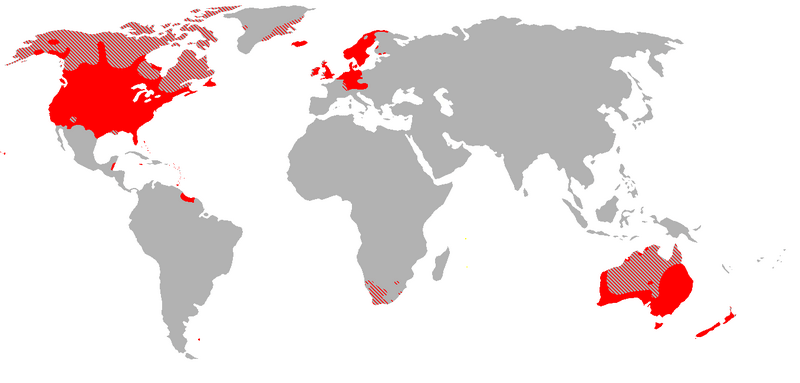 Spread of Germanic languages. Solid red indicates that a majority of inhabitants speaks a Germanic language. Striped red indicates that a sizeable minority (more than 10%) speaks a Germanic language. [© gfdl]
Spread of Germanic languages. Solid red indicates that a majority of inhabitants speaks a Germanic language. Striped red indicates that a sizeable minority (more than 10%) speaks a Germanic language. [© gfdl]
The Romance languages, a major branch of the IE, comprise all languages that descended from Latin, the language of the Roman Empire. The Romance languages have some 800 million native speakers worldwide, mainly in the Americas, Europe, and Africa; as well as in many smaller regions scattered through the world. The largest languages are Spanish and Portuguese, with about 400 and 200 million mother tongue speakers respectively, most of them outside Europe. Within Europe, French (with 80 million) and Italian (70 million) are the largest ones.
All Romance languages descend from Vulgar Latin, the language of soldiers, settlers, and slaves of the Roman Empire, which was substantially different from the Classical Latin of the Roman literati. Between 200 BC and 100 AD, the expansion of the Empire, coupled with administrative and educational policies of Rome, made Vulgar Latin the dominant native language over a wide area spanning from the Iberian Peninsula to the Western coast of the Black Sea. During the Empire's decadence and after its collapse and fragmentation in 5th century, Vulgar Latin evolve independently within each local area, and eventually diverged into dozens of distinct languages. The oversea empires established by Spain, Portugal and France after the 15th century then spread Romance to the other continents — to such an extent that about 2/3 of all Romance speakers are now outside Europe.
In spite of multiple influences from pre-Roman languages and from later invasions, the phonology, morphology, lexicon, and syntax of all Romance languages are predominantly derived from Vulgar Latin.
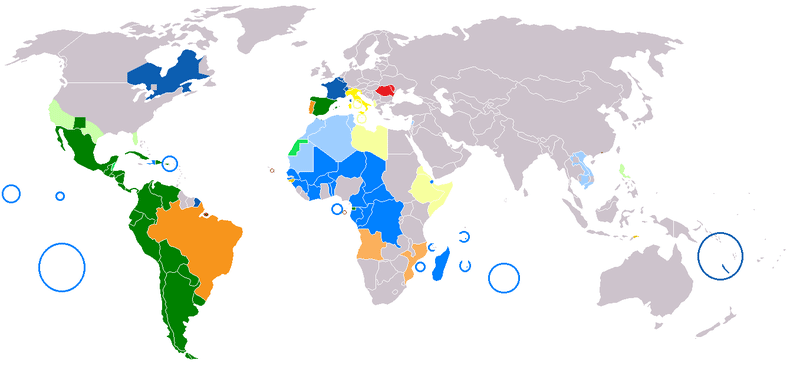 Romance languages in the World. Green - Spanish; Orange - Portuguese; Blue - French; Yellow - Italian; Red - Rumanian [
Romance languages in the World. Green - Spanish; Orange - Portuguese; Blue - French; Yellow - Italian; Red - Rumanian [![]() ]
]
The Slavic languages (also called Slavonic languages), a group of closely related languages of the Slavic peoples and a subgroup of IE languages, have speakers in most of Eastern Europe, in much of the Balkans, in parts of Central Europe, and in the northern part of Asia. The largest languages are Russian and Polish, with 165 and some 47 million speakers, respectively.
The oldest Slavic literary language was Old Church Slavonic, which later evolved into Church Slavonic.
 Distribution of the Slavic languages in Europe, in the areas where it is either recognized as an official language, or spoken by a majority. Also, in stripes, areas where a language was spoken before it got extinct or, the regions where it is best represented even if not spoken by a majority [
Distribution of the Slavic languages in Europe, in the areas where it is either recognized as an official language, or spoken by a majority. Also, in stripes, areas where a language was spoken before it got extinct or, the regions where it is best represented even if not spoken by a majority [![]() ]
]
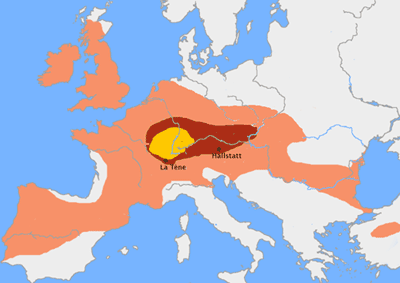 Distribution of the Celtic languages in Europe before Roman expansion. [© gfdl]
Distribution of the Celtic languages in Europe before Roman expansion. [© gfdl]
The Celtic languages are the languages descended from Proto-Celtic, or "Common Celtic", a branch of the greater IE language family. During the 1st millennium BC, they were spoken across Europe, from the southwest of the Iberian Peninsula and the North Sea, up the Rhine and down the Danube to the Black Sea and the Upper Balkan Peninsula, and into Asia Minor (Galatia), and even in Anatolia. Today, Celtic languages are now limited to a few enclaves in the British Isles and on the peninsula of Brittany in France.
The distinction of Celtic into different sub-families probably occurred about 1000 BC. The early Celts are commonly associated with the archaeological Urnfield culture, the La Tène culture, and the Hallstatt culture.
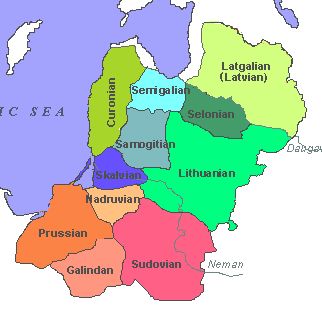 Old Baltic dialects, modified from (apparently not copyrighted) http://indoeuro.bizland.com/tree/balt/balt.html image
Old Baltic dialects, modified from (apparently not copyrighted) http://indoeuro.bizland.com/tree/balt/balt.html image
The Baltic languages are a group of related languages belonging to the IE language family and spoken mainly in areas extending east and southeast of the Baltic Sea in Northern Europe. The language group is sometimes divided into two sub-groups: Western Baltic, containing only extinct languages as Prussian or Galindan, and Eastern Baltic, containing both extinct and the two living languages in the group: Lithuanian and Latvian (including literary Latvian and Latgalian). While related, the Lithuanian, the Latvian, and particularly the Old Prussian vocabularies differ substantially from each other and are not mutually intelligible. The now extinct Old Prussian language has been considered the most archaic of the Baltic languages.
Albanian (gjuha shqipe) is a language spoken by over 8 million people primarily in Albania, Kosovo, and the former Yugoslav Republic of Macedonia, but also by smaller numbers of ethnic Albanians in other parts of the Balkans, along the eastern coast of Italy and in Sicily, as well other emigrant groups. The language forms its own distinct branch of the IE languages.
The Albanian language has no living close relatives among the IE languages. There is no scholarly consensus over its origin. Some scholars maintain that it derives from the Illyrian language, and others claim that it derives from Thracian. The former group doesn't exclude a relationship with Thracian.
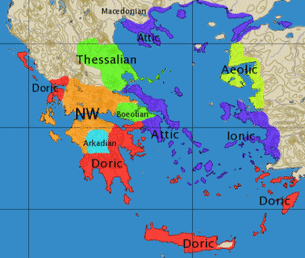 Distribution of old Greek dialects, ca. 400 BC, after Risch (1955) [© gfdl]
Distribution of old Greek dialects, ca. 400 BC, after Risch (1955) [© gfdl]
Greek (Greek Ελληνικά, "Hellenic") is an IE language with a documented history of 3,500 years. Today, it is spoken by 15 million people in Greece, Cyprus, the former Yugoslavia, particularly the former Yugoslav Republic of Macedonia, Bulgaria, Albania and Turkey.
Greek has been written in the Greek alphabet, the first true alphabet, since the 9th century B.C. and before that, in Linear B and the Cypriot syllabaries.
Greek literature has a long and rich tradition.
Greek has been spoken in the Balkan Peninsula since the 2nd millennium BC. The earliest evidence of this is found in the Linear B tablets dating from 1500 BC. The later Greek alphabet is unrelated to Linear B, and was derived from the Phoenician alphabet; with minor modifications, it is still used today.
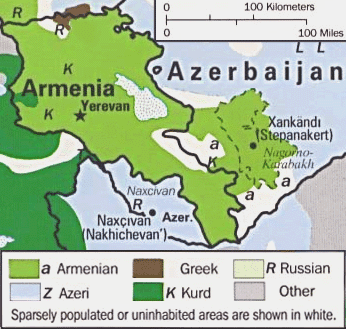 Eastern Armenian language today (Courtesy of The General Libraries, The University of Texas at Austin)
Eastern Armenian language today (Courtesy of The General Libraries, The University of Texas at Austin)
Armenian is an IE language spoken by the Armenian people in the Armenian Republic and also used by the Armenian Diaspora. It constitutes an independent branch of the Indo-European language family.
Armenian is regarded as a close relative of Phrygian. From the modern languages Greek seems to be the most closely related to Armenian. Armenian shares major isoglosses with Greek, and some linguists propose that the linguistic ancestors of the Armenians and Greeks were either identical or in a close contact relation.
Armenian is written in the Armenian alphabet, created by Saint Mesrop Mashtots in 406 AD. This alphabet, with two additional letters, is still used today.
Literature written in Armenian appeared by the 5th century. The written language of that time, called classical Armenian or Grabar, remained the Armenian literary language, with various changes, until the 19th century.
The Kurdish language (Kurdî in Kurdish) is spoken in the region loosely called Kurdistan, including Kurdish populations in parts of Iran, Iraq, Syria and Turkey. Kurdish is an official language in Iraq while it is banned in Syria. Before August 2002, the Turkish government placed severe restrictions on the use of Kurdish, prohibiting the language in education and broadcast media. In Iran, although it is used in the local media and newspapers, there are severe restrictions on its use in education. Teaching Kurmanji Kurdish is prohibited in Iranian schools.
The Kurdish language has its own historical development, continuity, grammatical system and rich living vocabularies in comparison to other members of the Iranian language family. The number of speakers in Turkey is deemed to be more than 15 million, but an exact census is not available.
Romany (or Romani) is the term used for the IE languages of the European Roma and Sinti. These Indo-Aryan languages should not be confused with either Rumanian or Romansh, both of which are Romance languages.
The Roma people (singular Rom; sometimes Rroma, Rrom), often referred to as Gypsies, are an ethnic group who live primarily in Europe. They are believed to be descended from nomadic peoples from northwestern India and Pakistan who began a Diaspora from the eastern end of the Iranian plateau into Europe and north Africa about 1,000 years ago. Sinte or Sinti is the name some communities of the nomadic people usually called "Gypsies" in English prefer for themselves. This includes communities known in German and Dutch as Zigeuner and in Italian as Zingari. They are closely related to, and are usually considered to be a subgroup of, the Roma people. Roma and Sinte do not form a majority in any state.
Today's dialects of Romany are differentiated by the vocabulary accumulated since their departure from Anatolia, as well as through divergent phonemic evolutions and grammatical features. Many Roma no longer speak the language or speak various new contact languages from the local language with the addition of Romany vocabulary.